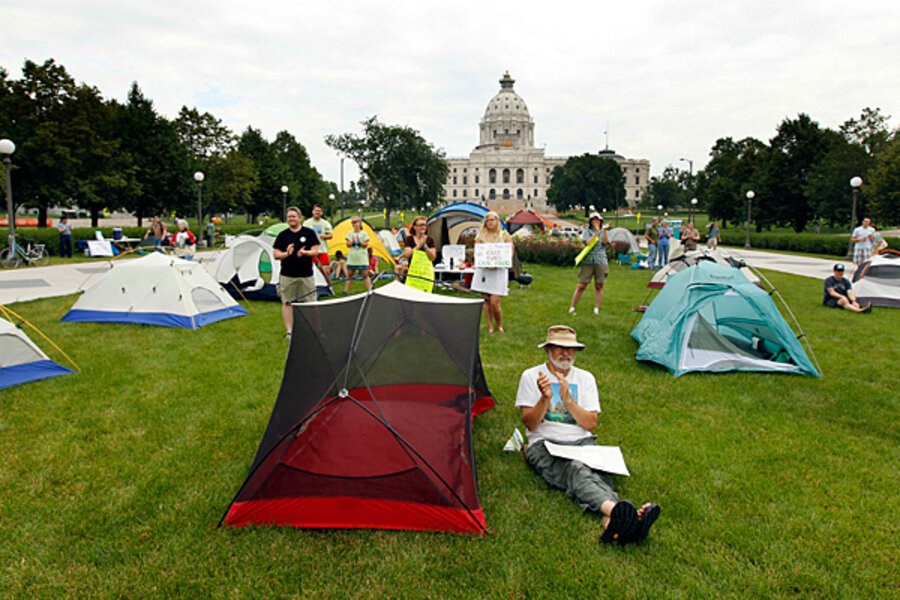Minnesota government shutdown: What could end it?
Loading...
| Chicago
The government shutdown in Minnesota is in its 10th day, and no end is in sight. Unlike stalemates between Republicans and Democrats that have taken place this year in nearby states including Wisconsin, Minnesota’s drama of wills has not mobilized supporters in the streets, nor are the two running media campaigns to tout solutions.
Still, this latest tug of war contains some familiar elements. It’s testing the tea party faction of the state’s Republican lawmakers, who control both houses, against a Democratic governor who has been weakened to the point that some capital-watchers say he will have to buckle.
“Polarization has arrived in Minnesota,” says Larry Jacobs, director of the Center for the Study of Politics and Governance at the University of Minnesota in Minneapolis. “The lesson from Minnesota is ... that you have a group of folks in the Republican Party who are so doubtful of the efficacy of government that a shutdown is seen as desirable in effect.”
Last week, Gov. Mark Dayton (D) met with Republican legislative leaders to address the failure the earlier week to plug a $5 billion deficit before the fiscal year began. Governor Dayton offered a $1-per-pack tobacco tax, along with health-care surcharges and a delay in school aid payments. He also proposed a temporary income-tax increase for those 7,700 Minnesotans making more than $1 million annually, which he said would generate an additional $500 million to $700 million over two years.
Republicans rejected the proposals, and Dayton went home with no weekend meetings scheduled. On Friday, the Fitch debt ratings agency lowered the state’s bond rating to AA+. The state had previously enjoyed the highest rating allowed – AAA.
Minnesota is now in what Steve Perry, managing editor of Politics in Minnesota in St. Paul, calls “a fairly soft shutdown” – in which essential social services and elementary schools receive court-mandated funding. But the threat looms that rising expenditures will push the state treasury into the red, causing layoffs and stoppages of major works projects, business permitting, and state education grants.
“There remains the potential of some unforeseen problems that could generate political heat and those, as far as I can see, revolve around the impact [the shutdown will have] on business,” Mr. Perry says.
At first blush, it would appear that Dayton’s proposal to tax the wealthy would curry some public sympathy. Taxing the upper-income bracket was “the core of what got [Dayton] elected governor in the first place,” says Perry.
A poll conducted by Public Policy Polling in late May shows that to help balance the state budget, 63 percent of Minnesotans would support a tax increase on the wealthiest 2 percent, compared with 32 percent who say the budget should be balanced only through cuts.
Still, Dayton has not taken his case to the media, unlike his predecessor, Republican Gov. Tim Pawlenty, who was seen as much more of a media star. Dayton has also acted differently from President Obama, who held a news conference on Monday to discuss the impasse in federal debt talks.
“Pawlenty was very adept at using the media to put a real hurt on Democrats who defied him,” Mr. Jacobs says. “The bully pulpit is a unique advantage of a governor or a president.”
So what will it take for the Minnesota government to open its doors again?
The exit strategy for the shutdown, some say, appears to be in the hands of moderates in both parties.
For legislators and the governor to cut their way out of the problem, they will need to use less of a butcher knife and more of a finely held scalpel, says Kathryn Pearson, who teaches political science at the University of Minnesota.
Yet in Minnesota, as in other states, the midterm elections last year resulted in a many freshmen lawmakers affiliated in some fashion with the tea party, whose quick ascent proved volatile.
“Some say, ‘Oh, Democrats only need to peel off a handful of Republicans in each chamber, and that will work.’ That is not the case: It has to be palpable to some Republicans and enough moderate Democrats to make up the difference,” Ms. Pearson says. “There are so many Republicans in each chamber who oppose any new revenue that this is going to be really tough.”
Jacobs is less sure that moderates will help steer the conflict into a resolution, saying “it is a political death wish” in the current climate for legislators on either side to break with their parties. At this point, he says, the Republicans are “being smarter politicians by sitting it out and making the governor come closer to them.”
He adds, “And why not? They’re sitting on the sidelines, and he keeps giving them things. They’re being rewarded by sitting out.”
That may keep the shutdown going long past the summer.
“I don't see a quick conclusion," said state Rep. Larry Howes (R) told the Minneapolis Star Tribune last week. “If this thing goes to the State Fair [on Labor Day weekend], it will probably go to January. That's my gut.”





